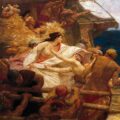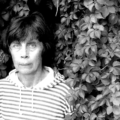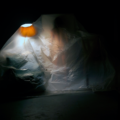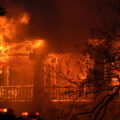#MotherLit: Barber, Mnookin, Parks, & Ross

Following up on the Motherhood issue (March-April 2017), Chloe García Roberts and Mia You asked four authors to reflect on the literature that become important to them after they became mothers.
We’d love to hear from you, too, all you many-gendered mothers out there across the globe, sharing this experience, so often in isolation. Tweet the books, essays, stories, and/or poems that you’ve found important to @CriticalFlame with the hashtag #MotherLit.
Thanks to Chloe and Mia for their editorial vision as well as to Jennifer Barber, Wendy Mnookin, Cecily Parks, and Anna Ross.
– DEP, Ed.
Jennifer Barber
I remember reading Eavan Boland’s poem “The Pomegranate” when my son and daughter were ages eleven and two. I was stunned by it. She takes a commonplace fear—those panicky moments when you can’t find your child—and equates them with the Persephone myth:
I walked out in a summer twilight
searching for my daughter at bed-time.
When she came running I was ready
to make any bargain to keep her.
I carried her back past whitebeams
and wasps and honey-scented buddleias.
But I was Ceres then and I knew
winter was in store for every leaf
on every tree on that road.
The poem understands that the toddler you accompany everywhere rapidly becomes the child who is at large in the neighborhood, who in turn takes shape as a teenager. Boland switches into the present tense in the next lines:
It is winter
and the stars are hidden.
I climb the stairs and stand where I can see
my child asleep beside her teen magazines,
her can of Coke, her plate of uncut fruit.
The pomegranate! How did I forget it?
She could have come home and been safe
and ended the story and all
our heart-broken searching but she reached
out a hand and plucked a pomegranate.
The poem, as it continues, radiates both a sense of loss and a sense of acceptance. It helped me realize then and helps me realize now that each phase of parenting is temporary. It sees that the myths we love most are the ones capable of returning us to our day-by-day lives, not with more wisdom, but with the certainty that we have fully felt the moments we’ve passed through.
Jennifer Barber’s collections of poetry are Works on Paper, recipient of the 2015 Tenth Gate Prize (The Word Works, 2016); Given Away (Kore Press, 2012), and Rigging the Wind, recipient of the 2002 First Book Award (Kore Press, 2003). Her poems have appeared in Poetry, the Missouri Review, the New Yorker, Agni, Orion, and elsewhere. She teaches at Suffolk University and is the founding and current editor of the literary journal Salamander.
Wendy Mnookin
Here are some texts that have helped me in my writing—about motherhood, about my children, about my grandchildren. And about my own childhood, because doesn’t motherhood do that, cast you into memory while insisting you stay anchored in the present?
Louise Glück’s Meadowlands helped me through a particularly difficult time in my writing. I didn’t want to write about my son’s drug addiction, and yet it was consuming my life: what else could I write about? In Meadowlands, Glück allows the story of her divorce to take up an entire book, giving space to different points of view and moods and moments in time. There’s shame and anger and sadness, but also humor and irony and the tyranny of the everyday. I read it over and over again as I was writing my book, To Get Here.
Dorianna Laux gave me a way to write about childhood that wasn’t sentimental or melodramatic. In “What My Father Told Me” she uses a matter-of-fact tone and simple language to convey the trauma of sexual abuse. And at the end, a question, “Where do the children sleep?” I hear an echo of that in my poem, “Questions, 1959,” when the child, who has been told her grandfather died of a broken heart, asks, “How do you die of a broken heart?”
And then, “Gabriel and the Water Shortage.” Sharon Olds describes her son in such vivid detail that at the end of the poem I know—well, not her son so much as her love for him. How does she do that? Long after I’ve forgotten the details of the poem, I still recite the title, gabriel and the water shortage, as a kind of mantra for my own writing.
Cecily Parks
I became a mother and discovered a new genre: the poem-turned-into-children’s-book. Perhaps re-discovered is more accurate, because some of these books were books that were read to me when I was a child, before I split poetry from prose, line from sentence, lyric from narrative.
The pleasures I now derive from an exquisitely fashioned line and break cannot rival the thrill that the not-yet-literate me felt when my mother’s fingers and thumb, with a sticky sound, found purchase on a page and, at the appropriate moment, flipped it, so that the owl and the pussycat in Edward Lear’s poem were suddenly, marvelously, at sea, the owl holding a coin between two finger-like primaries of his wing while his beloved trailed a clover-patterned scarf in the white bubbles beside their boat.
Or, in another poem-turned-into-children’s-book, this one by Donald Hall, the turn of the page revealed that the ox-cart man walking the many miles home from the market had walked so long that he walked into the night, the sinewy road he followed leading up a hill to a farmhouse with three bright windows, as if the wife, daughter, and son waiting there for him were made of light. When I was a child, the turning of the page not only materialized but accelerated the passage of time, which otherwise felt so slow, so full of waiting—in traffic, or at the dentist’s office, or while your mother spoke into a phone with a corkscrewed cord. In a book, time flew. Within three turns of the page, the owl and the pussycat had sailed for “a year and a day, / To the land where the Bong-tree grows.”
Within twenty page turns, a New England year had passed, and the ox-cart man was readying another ox and another newly built cart for the trip to Portsmouth. Both are real, the child’s time and the adult’s time, the poem time and the living time. Nonetheless, I now find it near impossible to believe in the slowness of time, when I can count on one hand the number of years that I can expect my twin daughters to continue asking me to read aloud to them.
“I know, I know, the true is untrue,” the girl speaker concedes in Delmore Schwartz’s poem-turned-into-children’s book. In that book, my favorite lines are the ones my daughters, cued by the colors of the illustrations, memorized first: “I am red, / I am green, / I am gold, / I am blue.” Each page turn yields a change in color, landscape, season, and wardrobe for the girl speaking the poem. Oddly enough, the girl’s physical appearance remains unchanged, while my off-the-page daughters regularly astound me with their needs for new shoes, larger clothing, more apples, more pizza. Untrue!, I think. The girl should have grown by the end of the book! Her pants should be up to her calves now!
But then, the thing happens that often happens when you read a book to children: my daughters want me to read it again. What happens then? A rewinding of time? An almost-slowness? It feels like it, or, more accurately, I let it feel like it, and position my fingers around the first page.
Cecily Parks is the author of the poetry collections Field Folly Snow (University of Georgia Press, 2008) and O’Nights (Alice James Books, 2015), and editor of The Echoing Green: Poems of Fields, Meadows, and Grasses (Everyman’s Library, 2016). She teaches at Texas State University.
Anna Ross
I came to motherhood after almost three years of trying, and failing, to have a baby. By the time I was pregnant enough with my daughter to actually believe that this might be the child who “stuck,” as much of the literature put it (reducing pregnancy to a feat of engineering as opposed to the “natural” and “miraculous” experience I’d once been promised), the years of miscarriage and attendant doctor’s consults, testing, research, diets, and advice both solicited and unsolicited had left me wary of any reading promising to enlighten me on what to “expect” from pregnancy, labor, birth, and what came after.
About a week before I went into labor with my daughter, a friend asked me if I’d made a “birth plan,” and I answered, rather tersely in my memory, that I planned to have a baby. Instead of reading about or drawing up blueprints for the impending birth, I dove into A Dance to the Music of Time, Anthony Powell’s twelve-volume cycle of novels set in London and various country houses, schools, and universities surrounding the city and spanning the years 1914 to 1971. The cycle is narrated by Nick Jenkins, an upper class Englishman (modeled on Powell) who chronicles the lives, careers, marriages, affairs, births, and deaths of a group of his friends and acquaintances against the backdrop of the World Wars and subsequent upheaval of English society during the first two thirds of the 20th century. The books are less a linear narrative than a recounting of recurring characters who circle around each other, colliding, connecting, disconnecting, finding one another again, much like the figures in the painting of the same name by Nicolas Poussin, upon which Powell based the novels.
The irony of the fact that I was gestating and then nursing my American-born daughter in 2007 while engrossed in the stories of this group of friends, most of them men, set in another country and century did not escape me. Was I trying to escape from my current reality with accounts of stiff-upper-lipped Englishmen waiting out The Blitz in London bomb shelters and coming to grips with (or, in the case of one character, losing his grip entirely due to) the counter-culture and politics of the 1960s “Happenings”? Or did I feel the need to situate this birth, this child, this act that I could not reverse, within a larger narrative: a history of births and their repercussions? (A few years later, while teaching Audre Lorde’s poem “Now That I Am Forever with Child” to a first year literature class, I remarked, after reading the lines “my legs were towers between which / a new world was passing” that the sense of irreversible newness Lorde is describing had struck me forcefully after giving birth to my own daughter. I had put something out into the world that I could never take back.) I did discover one consonance between reading A Dance to the Music of Time and my new motherhood, however: a month or so after I’d begun the cycle, my own mother mentioned that she, too, had read it while pregnant and nursing me more than thirty years before.
Perhaps historicism (or escapism?) was a family trait.
In The Year of Magical Thinking, Joan Didion writes of wishing that she could use a digital film editing system to “collapse the sequence of time, show you simultaneously all the frames of memory that come to me now” as she attempts to put into language her experience of the year following her husband’s sudden death from cardiac arrest, a year during which her daughter was hospitalized first for septic shock and later for a hematoma in her brain that eventually led to her death. Later in the book, Didion compares the grief of losing a parent, a loss with which she’s familiar, to the grief of losing a child or spouse. The former changes one’s sense of connection with the world, as though one is riding in an underwater submersible that from time to time comes into contact with “depth charges” of memory, temporarily derailing it’s passenger, who nonetheless continues on. The latter, she writes, situating herself within the relevant psychological literature in true Didion fashion, comes as an unmanageable, unfathomable, unending wave, severing all sense of reality—hence the “magical thinking” of her title. Here was another book I read early on in motherhood, perhaps in that first year—perhaps I went directly from Powell to Didion?
Again, beyond my love of Didion’s prose, which always seems to unlock something inside my own writing mind, why would I have chosen to read a book whose unsparing subject was the inescapable nature of loss and grief? I finally had the child I’d wished and worked so hard to have, but when I read that image of the submarine (Didion was quoting from a letter sent to her by a former priest after her mother’s death), I immediately thought of the pregnancies I’d lost—dim rounded shapes that lacked the blinking light of heartbeat run aground on the ultrasound screen. This new child, with her strong, unceasing heartbeat, could not obscure the memory of those others, I found, joyfully preoccupied by her every move though I was. And perhaps another, darker motive lay behind this knowledge. Didion herself had been unable to conceive a child, and her own daughter, Quintana Roo, was adopted. It is possible that in reading about the loss of another’s beloved and long-wished-for daughter, I was attempting to prepare myself for what I presumed, through my conditioning over the previous few years, would be the death of my own. My daughter turned ten this year, and still I go into her room each night to check that she is breathing, laying my hand on her chest or back and counting one-two-three breaths, before I can go to bed myself.
Robert Hass, responding to a birth announcement email I sent out after my second child—a son—was born, reminded me to read The Grand Permission: New Writings on Poetics and Motherhood. Now sleepless and nursing an infant while attempting to entertain and placate his three-year-old sister, I certainly needed permission for something, although I hadn’t quite worked out what or why. Edited by Brenda Hillman, Hass’s wife, and Patricia Dienstfrey, The Grand Permission is a collection of essays, some personal and anecdotal and others critical, that address the conundrum of being a mother and a poet—can one do and be both?
I was heartened to notice that each essayist included the names and birth years of her child(ren) in the biographical note following her piece. Reading the first essay in the book, Maxine Kumin’s “Motherhood and Poetics,” in which she details her long and collaborative friendship with Anne Sexton, was like listening in on a phone conversation between an unquestionably brilliant and sophisticated older sister and her friend. Kumin both affirmed and assuaged most of my deepest fears about both writing as a mother and writing about motherhood, as when she described Sexton’s and her reactions to being selected as charter members of the Radcliffe Institute for Advanced Study.
According to Kumin, this accolade finally gave Sexton the nerve to excuse herself from a phone conversation by saying that she was in the middle of writing a poem rather than claiming that she “had a cake in the oven,” an anecdote equal parts surreal comedy (“a cook she was not,” Kumin tells us) and sobering illustration of the social mores of the day. Kumin does warn that “there is still a bountiful supply of sexist condescension that regards poems about domestic relationships as possibly charming and appealing but unworthy of serious critique,” an observation that continues to ring true in my experience (unless, of course, said domestic relationship is chronicled by a man), but she also cheerfully proclaims herself “shameless” with regard to writing such poems—a model indeed.
But the essay in The Grand Permission that most immediately claimed my attention was Eavan Boland’s “The Other Sylvia Plath.” Boland details Plath’s final autumn, in 1962, in her farmhouse in Devon, England, following the dissolution of her marriage with Ted Hughes. In these few months, she wrote many of the poems that would be published, posthumously, in Ariel, poems in which motherhood consistently redeems Plath’s despair. Boland claims that Plath transforms the traditional nature poem in the poems of motherhood she wrote that fall, changing it from a poem written by poets—Boland uses Frost and Wordsworth as her examples—who are “willing to be instructed by nature” into a poem in which Plath is “instructing nature,” using natural elements and imagery as a means of expressing her shock, anger, and sense of alienation as she faces the end of her marriage but also her joy in the beautiful new baby who might save her. Boland takes as her example “Nick and the Candlestick,” a poem in which Plath rises from bed in the dark to confront “Black bat airs” in an “Old cave of calcium / Icicles” inhabited by “newts” and a cold so invasive she compares it to “panes of ice // A vice of knives / a piranha.” All of this horror dissolves when Plath’s “candle / Gulps and recovers” so that she, and we, can see her child:
O love, how did you get here?
O embryoRemembering, even in sleep,
Your crossed position.
The blood blooms cleanIn you, ruby.
Somehow (how?!), I had overlooked Plath’s poems of motherhood before this, but the physicality of her imagery—the child is an “embryo” who still sleeps in the “position” he kept in the womb—and her admission of the sense of dislocation and isolation, even grief, that mothering can provoke sent me running to find her collected poems on my shelf. I, too, had a young daughter and an infant son born in January. I, too, found myself rising alone in the night and stumbling, “cow heavy,” yes, through darkness so opaque as to seem a “cave,” my feet bitten with the cold as I lifted my son from his cot to nurse him. I, too, knew the relief of leaning against the warmth of his small, curled body. Plath’s disassembly and reconstruction of the landscape surrounding her seems to arise directly out of her motherhood, and this makes sense—what is motherhood but a revision, a rewriting of the instruction manual? Suddenly we meet ourselves again within the gaze of our children, a gaze free of assumption and association—the freight of our previous lives that we now must unpack, examine, and rearrange. In such a state of consciousness, the darkness of the midnight bedroom must become a cave, Platonic or actual, in which we stumble and try to right ourselves.
Plath’s sudden reflection allowed me to look at myself again, after the gorgeous distraction of other people’s live in A Dance to the Music of Time, or Didion’s warning griefs. So many of the poems seemed to have been waiting for me to return: “Tulips,” which Plath wrote after her own miscarriage; her self-effacement in “Morning Song;” the questions of power, protection, and creation she worries in “Wintering” (“Will the hive survive?”). As Plath detailed in her poem, “Mirror,” not everything I saw when I looked at my own life as mother, as woman, was positive (and some of it was downright terrifying and enraging), but there was still comfort in looking, in recognizing that I was still here after all—a self, a body, not merely a constellation of reactions to loss, anxiety, and expectation. Re-encountering these poems led me forward (and back again) to Sexton, Kumin, Audre Lorde, Lucille Clifton, Gwendolyn Brooks, Muriel Rukeyser, C.D. Wright, Adrienne Rich (the list continues)—poets who approached women’s bodies and their lives frankly as often difficult or imperfect, but also sources of actualization (those “towers” in Lorde’s poem above) and strength. Motherhood was part of this power, or could be, but only a motherhood that wouldn’t deny the woman from whom it arose. “The pain / You wake to is not yours,” Plath says to her son in “Nick and the Candlestick.” It was Plath’s “pain,” of course, and perhaps mine—perhaps all of ours—but hers first and foremost.
Reading these lines, so straightforward in their admission of grief within love, I was able to consider how I might admit my own, and how I might begin again to write it all down.
Anna Ross is the author of the collections If a Storm, Figuring,and Hawk Weather. Her work has appeared in The Paris Review, The New Republic, Southern Review, Southern Humanities Review and elsewhere. She teaches in the Writing, Literature & Publishing Program at Emerson College and is a contributing poetry editor and reviewer for Salamander.





